
The Patriarchal Cathedral Basilica of Saint Mark, commonly known as St Mark's Basilica, is the cathedral church of the Patriarchate of Venice; it became the episcopal seat of the Patriarch of Venice in 1807, replacing the earlier cathedral of San Pietro di Castello. It is dedicated to and holds the relics of Saint Mark the Evangelist, the patron saint of the city.

Lucia of Syracuse (283–304), also called Saint Lucia was a Roman Christian martyr who died during the Diocletianic Persecution. She is venerated as a saint in Catholic, Anglican, Lutheran, and Eastern Orthodox Christianity. She is one of eight women explicitly commemorated by Catholics in the Canon of the Mass. Her traditional feast day, known in Europe as Saint Lucy's Day, is observed by Western Christians on 13 December. Lucia of Syracuse was honored in the Middle Ages and remained a well-known saint in early modern England. She is one of the best known virgin martyrs, along with Agatha of Sicily, Agnes of Rome, Cecilia of Rome, and Catherine of Alexandria.

Lorenzo Lotto was an Italian painter, draughtsman, and illustrator, traditionally placed in the Venetian school, though much of his career was spent in other north Italian cities. He painted mainly altarpieces, religious subjects and portraits. He was active during the High Renaissance and the first half of the Mannerist period, but his work maintained a generally similar High Renaissance style throughout his career, although his nervous and eccentric posings and distortions represented a transitional stage to the Florentine and Roman Mannerists.
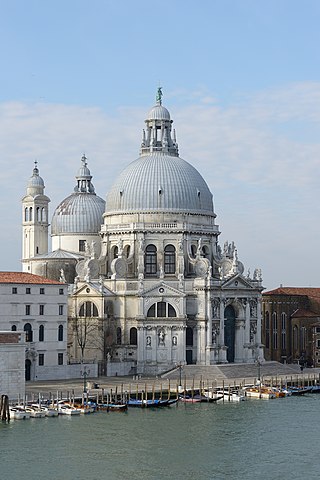
Santa Maria della Salute, commonly known simply as the Salute, is a Roman Catholic church and minor basilica located at Punta della Dogana in the Dorsoduro sestiere of the city of Venice, Italy.

Giovanni Battista Cima, also called Cima da Conegliano, was an Italian Renaissance painter, who mostly worked in Venice. He can be considered part of the Venetian school, though he was also influenced by Antonello da Messina, in the emphasis he gives to landscape backgrounds and the tranquil atmosphere of his works.

The Žiča Monastery is an early 13th-century Serbian Orthodox monastery near Kraljevo, Serbia. The monastery, together with the Church of the Holy Dormition, was built by the first King of Serbia, Stefan the First-Crowned and the first Head of the Serbian Church, Saint Sava.
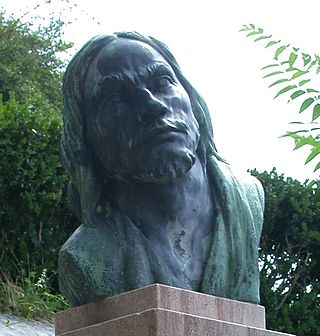
Pordenone, Il Pordenone in Italian, is the byname of Giovanni Antonio de’ Sacchis, an Italian Mannerist painter, loosely of the Venetian school. Vasari, his main biographer, wrongly identifies him as Giovanni Antonio Licinio. He painted in several cities in northern Italy "with speed, vigor, and deliberate coarseness of expression and execution—intended to shock".

San Giorgio Maggiore is a 16th-century Benedictine church on the island of the same name in Venice, northern Italy, designed by Andrea Palladio, and built between 1566 and 1610. The church is a basilica in the classical Renaissance style and its brilliant white marble gleams above the blue water of the lagoon opposite the Piazzetta di San Marco and forms the focal point of the view from every part of the Riva degli Schiavoni.

Marina, distinguished as Marina the Monk and also known as Marinos, Pelagia and Mary of Alexandria, was a Christian saint from part of Asian Byzantium, generally said to be present-day Lebanon. Details of the saint's life vary.
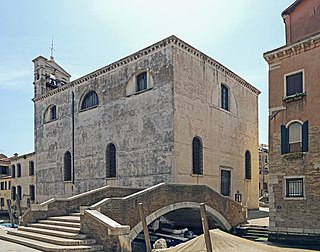
San Marziale is a church building in the sestiere or neighborhood of Cannaregio in Venice.

Cristoforo Moro was the 67th Doge of Venice. He reigned from 1462 to 1471.

Jesolo is a seaside resort town and comune of 26,447 inhabitants in the Metropolitan City of Venice, Italy. With around six million visitors per year, Jesolo is one of the largest beach resorts in the country, and ranks 7th overall as a tourist destination, and fourth most popular Italian seaside resort. With 204,711.4 visits per thousand inhabitants, it is also one of the 50 Italian towns with the greatest tourist pressure. Its 15 kilometres of beaches and proximity to central Europe make it a favourite destination of many Russian, German, Austrian, Dutch and French visitors.
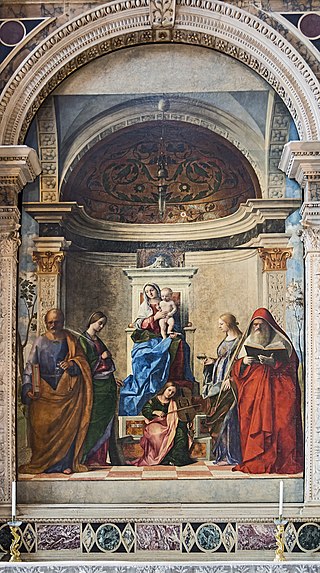
The San Zaccaria Altarpiece is a painting by the Italian Renaissance painter Giovanni Bellini, executed in 1505 and located in the church of San Zaccaria, Venice.

The Diocese of Castello, originally the Diocese of Olivolo, is a former Roman Catholic diocese that was based on the city of Venice in Italy. It was established in 774, covering the islands that are now occupied by Venice. Throughout its existence there was tension between the diocese, the Patriarchate of Grado to which it was nominally subordinate, and the Doge of Venice. Eventually in 1451 the diocese and the patriarchate were merged to form the Archdiocese of Venice.

The Goražde printing house was one of the earliest printing houses among the Serbs, and the first in the territory of present-day Bosnia and Herzegovina. Established in 1519 in Venice, it was soon relocated to the Serbian Orthodox Church of Saint George in the village of Sopotnica near Goražde, in the Ottoman Sanjak of Herzegovina. It was founded and run by Božidar Ljubavić, also known as Božidar Goraždanin, who was a prominent merchant from Goražde. His son Teodor Ljubavić, a hieromonk of the Mileševa Monastery, managed the work of the printing house. It worked until 1523, producing three books, which are counted among the better accomplishments of early Serb printers.
Božidar Ljubavić, better known as Božidar Goraždanin, was founder of the Goražde printing house, the second Serbian language printing house and one of the earliest printing houses on the Balkans. Since 25 October 1519 he printed books on Cyrillic alphabet, first in Venice and then in the Church of Saint George in Sopotnica, Sanjak of Herzegovina, Ottoman Empire in period 1519–23. Only four printing presses were operational during the entire Ottoman period in Bosnia. The first press was press of Božidar Goraždanin while other three presses existed only in the 19th century. In 1523 his printing house became nonoperational.

The Holy Transfiguration Monastery is a Serbian Orthodox monastery. It is located in Campbellville, Milton, Ontario and it serves as the headquarters of the Eparchy of Canada.

All Serbian Saints Serbian Orthodox Church is a Serbian Orthodox church located in Mississauga, Ontario, Canada. It is dedicated to all the Serbian saints.
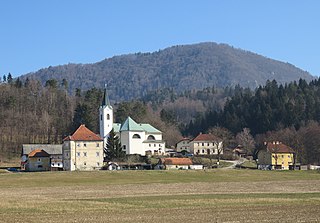
Sveta Helena is a former settlement in the Municipality of Dol pri Ljubljani in central Slovenia. It is now part of the village of Kamnica. The area is part of the traditional region of Upper Carniola. The municipality is now included in the Central Slovenia Statistical Region.


















